Fabrication of Ni-Rich 58NiTi and 60NiTi from Elementally Blended Ni and Ti Powders by a Laser Powder Bed Fusion Technique: Their Printing, Homogenization and Densification
Abstract
:1. Introduction
2. Results and Discussion
2.1. Powder Characteristics
2.2. Processing of the As-Printed Parts
2.3. Characterization of the As-Printed Parts
2.4. Microstructural Homogenization and Densification
3. Materials and Methods
3.1. Powder Characterization
3.2. LPBF Processing and HIP Treatment
3.3. Characterization of Processed Parts
4. Conclusions
- The printability of powder mixtures was reduced under the conditions that the laser powers of above 50 watts were employed to print the parts. In addition, for the sets of processing parameters having a laser power of 50 watts, the powders showed the best printability with the set of processing parameters (set 1) having the lowest laser energy input (27.70 J/mm3). Set 4, having a laser power of 50 watts, was the highest used energy input (39.68 J/mm3) that the powder mixtures showed an almost reasonable printability with.
- Due to the effect of the melt pool temperature and generated residual stresses, the more Ni-rich powder mixture, with about 60 wt.% Ni and 40 wt.% Ti in its composition showed a relatively better printability than the one with about 58 wt.% Ni and 42 wt.% Ti.
- Microstructures of the parts printed by these processing sets, regardless of the composition of the used powder mixtures, were inhomogeneous and consisted of not fully reacted Ni-rich and Ti-rich areas. Due to the differences existing in the energy inputs of the printing sets causing different levels of residual stresses and diffusion amongst printed layers, microstructures of parts printed by set 1 were dominant with large pores and the ones with set 4 with cracks.
- Applying an elementary HIP treatment at 1050 °C for 4 h, homogenized the as-printed parts and microstructures conforming to those of 58NiTi and 60NiTi alloys were obtained. However, the applied treatments could not eliminate the cracks and pores existing in the microstructures of as-printed parts. The average relative densities of the parts obtained from samples printed by set 4 (ranging between ~96 and ~98%) were relatively higher than those processed from parts printed by set 1 (ranging between ~93 and ~94%).
- Secondary HIP treatments were designed to eliminate these flaws from the microstructures of elementary HIP-treated parts. However, this aim could not be achieved under conditions that the applied HIP temperatures were below the ones at which the dimensional integrities of parts were deteriorated.
- Regardless of the composition of the used powder mixtures and processing sets used to print the parts, the average apparent hardness (ranging between ~38.8 and ~46.1 HRC) and relative densities (ranging between ~94 and ~97%) of the secondary HIP-treated parts, performed at the maximum temperatures at which the dimensional integrities of the parts were respected, were negligibly different as compared to the average apparent hardness (ranging between ~42.3 and ~44.8 HRC) and relative densities of elementary HIP-treated ones (ranging between ~93 and ~98%).
- Applying the final hardening treatment on the secondary HIP treated parts, processed from samples printed by set 1, resulted in a significant drop of the average apparent hardness (ranging between ~38.9 and ~42.4 HRC) and relative densities (ranging between ~94 and ~95%) to ranges between ~19.6–~26.1 HRC and ~83–~84%, respectively. The amounts and sizes of the pores existing in the microstructures of these secondary HIP-treated parts were significantly increased due to the effects caused by the conduction of this treatment.
- The 60NiTi parts showed a higher hardening potential than the 58NiTi ones. The applied hardening treatments decreased the relative density of secondary HIP-treated 58NiTi and 60NiTi parts, processed from samples printed by set 4, from around ~97% to a range between ~93 and ~94%. These treatments led to the widening of cracks that existed in the microstructures of the secondary HIP-treated parts. The obtained average hardness values of the hardened 58NiTi parts (~35.8 HRC) were decreased insignificantly as compared to those of secondary HIP-treated 58NiTi ones (~46.1 HRC), due to the effects caused by the hardening treatment. However, the hardening treatments, despite not being able to fully dissolve the Ni-rich Ni3Ti and Ni3Ti2 phases existing in the microstructure of furnace-cooled 60NiTi samples, led to the increase in hardness values of 60NiTi parts from ~38.8 HRC to ~45.9 HRC.
Author Contributions
Funding
Institutional Review Board Statement
Informed Consent Statement
Data Availability Statement
Acknowledgments
Conflicts of Interest
References
- Hornbuckle, B.C.; Yu, X.X.; Noebe, R.D.; Martens, R.; Weaver, M.L.; Thompson, G.B. Hardening behavior and phase decomposition in very Ni-rich Nitinol alloys. Mater. Sci. Eng. A 2015, 639, 336–344. [Google Scholar] [CrossRef]
- Otsuka, K.; Ren, X. Physical metallurgy of Ti–Ni-based shape memory alloys. Prog. Mater. Sci. 2005, 50, 511–678. [Google Scholar] [CrossRef]
- Thomas, F. The Effect of Various Quenchants on the Hardness and Microstructure of 60-NITINOL. U.S. Patent NASA/TM-2015-218463, 1 January 2015. [Google Scholar]
- Benafan, O.; Garg, A.; Noebe, R.; Skorpenske, H.; An, K.; Schell, N. Deformation characteristics of the intermetallic alloy 60NiTi. Intermetallics 2017, 82, 40–52. [Google Scholar] [CrossRef] [Green Version]
- Della Corte, C.; Stanford, M.K.; Jett, T.R. Rolling Contact Fatigue of Superelastic Intermetallic Materials (SIM) for Use as Resilient Corrosion Resistant Bearings. Tribol. Lett. 2015, 57, 1–10. [Google Scholar] [CrossRef]
- Bertheville, B.; Neudenberger, M.; Bidaux, J.-E. Powder sintering and shape-memory behaviour of NiTi compacts synthesized from Ni and TiH2. Mater. Sci. Eng. A 2004, 384, 143–150. [Google Scholar] [CrossRef]
- Stanford, M.K. Hardness and Microstructure of Binary and Ternary Nitinol Compounds. U.S. Patent NASA/TM-2016-218946, 1 December 2016. [Google Scholar]
- DellaCorte, C.; Noebe, R.; Stanford, M.; Padula, S. Resilient and corrosion-proof rolling element bearings made from superelastic Ni-Ti alloys for aerospace mechanism applications. In Proceedings of the ASTM International Symposium on Rolling Element Bearings Symposium, Anaheim, CA, USA, 13–15 April 2011. [Google Scholar]
- Khanlari, K.; Ramezani, M.; Kelly, P.; Neitzert, T. Effect of Hafnium Addition in 60NiTi Alloy Hardened Under Open Atmosphere Conditions. Met. Microstruct. Anal. 2018, 7, 476–486. [Google Scholar] [CrossRef]
- Dellacorte, C.; Pepper, S.; Noebe, R.; Hull, D.; Glennon, G. Intermetallic Nickel-Titanium Alloys for Oil-Lubricated Bearing Applications. U.S. Patent NASA/TM-2009-215646, 1 March 2009. [Google Scholar]
- DellaCorte, C.; Moore, L.E., III; Clifton, J.S. The Effect of Pre-Stressing on the Static Indentation Load Capacity of the Superelastic 60NiTi. U.S. Patent NASA/TM-2013-216479, 1 January 2013. [Google Scholar]
- Khanlari, K.; Ramezani, M.; Kelly, P. 60NiTi: A Review of Recent Research Findings, Potential for Structural and Mechanical Applications, and Areas of Continued Investigations. Trans. Indian Inst. Met. 2017, 71, 781–799. [Google Scholar] [CrossRef]
- Della Corte, C. Novel Super-Elastic Materials for Advanced Bearing Applications. Adv. Sci. Technol. 2014, 89, 1–9. [Google Scholar] [CrossRef]
- Della Corte, C. The Effect of Indenter Ball Radius on the Static Load Capacity of the Superelasic 60NiTi for Rolling Element Bearings. U.S. Patent NASA/TM-2014-216627, 1 April 2014. [Google Scholar]
- Julien, G.J. Manufacturing of Nitinol Parts and Forms. U.S. Patent 6422010, 23 July 2002. [Google Scholar]
- Khanlari, K.; Shi, Q.; Li, K.; Yan, X.; Cao, P.; Wang, X.; Liu, X. Development of hardening treatments for 58Ni39Ti-3Hf alloy system as compared to baseline 60NiTi. Intermetallics 2021, 137, 107282. [Google Scholar] [CrossRef]
- Khanlari, K.; Ramezani, M.; Kelly, P.; Cao, P.; Neitzert, T. Comparison of the reciprocating sliding wear of 58Ni39Ti-3Hf alloy and baseline 60NiTi. Wear 2018, 408–409, 120–130. [Google Scholar] [CrossRef]
- Khanlari, K.; Ramezani, M.; Kelly, P.; Cao, P.; Neitzert, T. Reciprocating Sliding Wear Behavior of 60NiTi As Compared to 440C Steel under Lubricated and Unlubricated Conditions. Tribol. Trans. 2018, 61, 991–1002. [Google Scholar] [CrossRef]
- Khanlari, K.; Ramezani, M.; Kelly, P.; Cao, P.; Neitzert, T. An Investigation on Reasons Causing Inferiority in Unlubricated Sliding Wear Performance of 60NiTi as Compared to 440C Steel. Tribol. Trans. 2018, 62, 96–109. [Google Scholar] [CrossRef]
- DellaCorte, C.; Moore, L.E., III; Clifton, J.S. Static Indentation Load Capacity of the Superelastic 60NiTi for Rolling Element Bearings. U.S. Patent NASA/TM-2012-216016, 29 May 2012. [Google Scholar]
- Stanford, M.K. Hot Isostatic Pressing of 60-Nitinol; NASA/TM-2015-218884; NASA Glenn Research Center: Cleveland, OH, USA, 2015.
- Della Corte, C.; Glennon, G. Ball Bearings Comprising Nickel-Titanium and Methods of Manufacturing Thereof. U.S. Patent 8182741, 22 May 2012. [Google Scholar]
- Della Corte, C.; Howard, A.; Thomas, F.; Stanford, M. Microstructural and Material Quality Effects on Rolling Contact Fatigue of Highly Elastic Intermetallic NiTi Ball Bearings. U.S. Patent NASA/TM-2017-219466, 1 March 2017. [Google Scholar]
- Elahinia, M.; Shayesteh Moghaddam, N.; Taheri Andani, M.; Amerinatanzi, A.; Bimber, B.A.; Hamilton, R.F. Fabrication of NiTi through additive manufacturing: A review. Prog. Mater. Sci. 2016, 83, 630–663. [Google Scholar] [CrossRef] [Green Version]
- Wang, X.; Kustov, S.; Van Humbeeck, J. A Short Review on the Microstructure, Transformation Behavior and Functional Properties of NiTi Shape Memory Alloys Fabricated by Selective Laser Melting. Materials 2018, 11, 1683. [Google Scholar] [CrossRef] [Green Version]
- Shishkovsky, I.; Yadroitsev, I.; Smurov, I. Direct Selective Laser Melting of Nitinol Powder. Phys. Procedia 2012, 39, 447–454. [Google Scholar] [CrossRef] [Green Version]
- Elahinia, M.H.; Hashemi, M.; Tabesh, M.; Bhaduri, S.B. Manufacturing and processing of NiTi im-plants: A review. Prog. Mater. Sci. 2012, 57, 911–946. [Google Scholar] [CrossRef]
- Farber, E.; Zhu, J.-N.; Popovich, A.; Popovich, V. A review of NiTi shape memory alloy as a smart material produced by additive manufacturing. Mater. Today Proc. 2020, 30, 761–767. [Google Scholar] [CrossRef]
- Sabahi, N.; Chen, W.; Wang, C.-H.; Kruzic, J.J.; Li, X. A Review on Additive Manufacturing of Shape-Memory Materials for Biomedical Applications. JOM 2020, 72, 1229–1253. [Google Scholar] [CrossRef]
- Zhu, J.; Zeng, Q.; Fu, T. An updated review on TiNi alloy for biomedical applications. Corros. Rev. 2019, 37, 539–552. [Google Scholar] [CrossRef]
- Khanlari, K.; Shi, Q.; Li, K.; Hu, K.; Cao, P.; Liu, X. Effects of printing volumetric energy densities and post-processing treatments on the microstructural properties, phase transformation temperatures and hardness of near-equiatomic NiTinol parts fabricated by a laser powder bed fusion technique. Intermetallics 2021, 131, 107088. [Google Scholar] [CrossRef]
- Wang, C.; Tan, X.; Du, Z.; Chandra, S.; Sun, Z.; Lim, C.; Tor, S.; Wong, C. Additive manufacturing of NiTi shape memory alloys using pre-mixed powders. J. Mater. Process. Technol. 2019, 271, 152–161. [Google Scholar] [CrossRef]
- Gureev, D.M.; Petrov, A.L.; Shishkovsky, I.V. Formation of intermetallic phases under laser sintering of powdered SHS compositions. In Proceedings of the 6th International Conference on Industrial Lasers and Laser Applications ’98, Shatura, Russia, 27–29 June 1998; SPIE: Bellingham, WA, USA, 1999; Volume 3688, pp. 237–242. [Google Scholar]
- Shishkovsky, I.V.; Kuznetsov, M.V.; Morozov, Y.G.; Parkin, I.P. Laser-induced combustion syn-thesis of 3D functional materials: Computer-aided design. J. Mater. Chem. 2004, 14, 3444–3448. [Google Scholar] [CrossRef]
- Shishkovskii, I.V.; Makarenko, A.G.; Petrov, A.L. Conditions for SHS of intermetallic compounds with selective laser sintering of powdered compositions. Combust. Explos. Shock Waves 1999, 35, 166–170. [Google Scholar] [CrossRef]
- Khanlari, K.; Shi, Q.; Li, K.; Xu, P.; Cao, P.; Liu, X. An investigation into the possibility to eliminate the microstructural defects of parts printed using a Ni-rich Ni-Ti elemental powder mixture. Mater. Res. Express 2020, 7, 106503. [Google Scholar] [CrossRef]
- Olakanmi, E.O.T.; Cochrane, R.F.; Dalgarno, K.W. A review on selective laser sintering/melting (SLS/SLM) of aluminium alloy powders: Processing, microstructure, and properties. Prog. Mater. Sci. 2015, 74, 401–477. [Google Scholar] [CrossRef]
- Vora, P.; Mumtaz, K.; Todd, I.; Hopkinson, N. AlSi12 in-situ alloy formation and residual stress reduction using anchorless selective laser melting. Addit. Manuf. 2015, 7, 12–19. [Google Scholar] [CrossRef] [Green Version]
- Cai, C.; Radoslaw, C.; Zhang, J.; Yan, Q.; Wen, S.; Song, B.; Shi, Y. In-situ preparation and formation of TiB/Ti-6Al-4V nanocomposite via laser additive manufacturing: Microstructure evolution and tribological behavior. Powder Technol. 2019, 342, 73–84. [Google Scholar] [CrossRef]
- Khanlari, K.; Ramezani, M.; Kelly, P.; Hayat, M.; Cao, P.; Neitzert, T. An Investigation on Micro-structural and Mechanical Properties of Porous 60NiTi Parts Solutionized by Different Cost-Effective Methods. Metallogr. Microstruct. Anal. 2018, 7, 334–346. [Google Scholar] [CrossRef]
- Khanlari, K.; Ramezani, M.; Kelly, P.; Cao, P.; Neitzert, T. Mechanical and microstructural characteristics of as-sintered and solutionized porous 60NiTi. Intermetallics 2018, 100, 32–43. [Google Scholar] [CrossRef]
- Khanlari, K.; Ramezani, M.; Kelly, P.; Hayat, M.D.; Cao, P.; Neitzert, T.R. Effects of Open Atmosphere Solutionizing Treatment on the Microstructural and Mechanical Properties of Porous 60NiTi Parts. Key Eng. Mater. 2018, 770, 87–94. [Google Scholar] [CrossRef]
- Chen, G.; Liss, K.-D.; Cao, P. In situ observation and neutron diffraction of NiTi powder sintering. Acta Mater. 2014, 67, 32–44. [Google Scholar] [CrossRef]
- Khanlari, K.; Ramezani, M.; Kelly, P.; Cao, P.; Neitzert, T. Synthesis of Assintered 60NiTi Parts with a High Open Porosity Level. Mater. Res. 2018, 21, e20180088. [Google Scholar] [CrossRef]
- Bertheville, B.; Bidaux, J.-E. Enhanced powder sintering of near-equiatomic NiTi shape-memory alloys using Ca reductant vapor. J. Alloys Compd. 2005, 387, 211–216. [Google Scholar] [CrossRef]
- Khanlari, K.; Shi, Q.; Hu, K.; Yan, Z.; Kelly, P.; Cao, P.; Liu, X. A study on the possibility to process dense 60NiTi from elementally blended Ni and Ti powders. Vacuum 2021, 192, 110500. [Google Scholar] [CrossRef]
- Adharapurapu, R.R. Phase Transformations in Nickel-Rich Nickel-Titanium Alloys: Influenece of Strain-Rate, Temperature, Thermomechanical Treatment and Nickel Composition on the Shape Memory and Superelastic Characteristics. Ph.D. Thesis, University of California, San Diego, CA, USA, 2007. [Google Scholar]
- Cooke, A.; Slotwinski, J. Properties of Metal Powders for Additive Manufacturing: A Review of the State of the Art of Metal Powder Property Testing; NIST: Gaithersburg, MD, USA, 2012.
- DellaCorte, C.; Wozniak, W.A. Design and Manufacturing Considerations for Shockproof and Corrosion-Immune Superelastic Nickel-Titanium Bearings for a Space Station Application. U.S. Patent NASA/TM-2012-216015, 1 May 2012. [Google Scholar]
- ASTM B962–08; Standard Test Methods for Density of Compacted or Sintered Powder Metallurgy (PM) Products Using Archimedes’ Principle. ASTM International: West Conshohocken, PA, USA, 2008. Available online: https://www.astm.org (accessed on 5 June 2015).

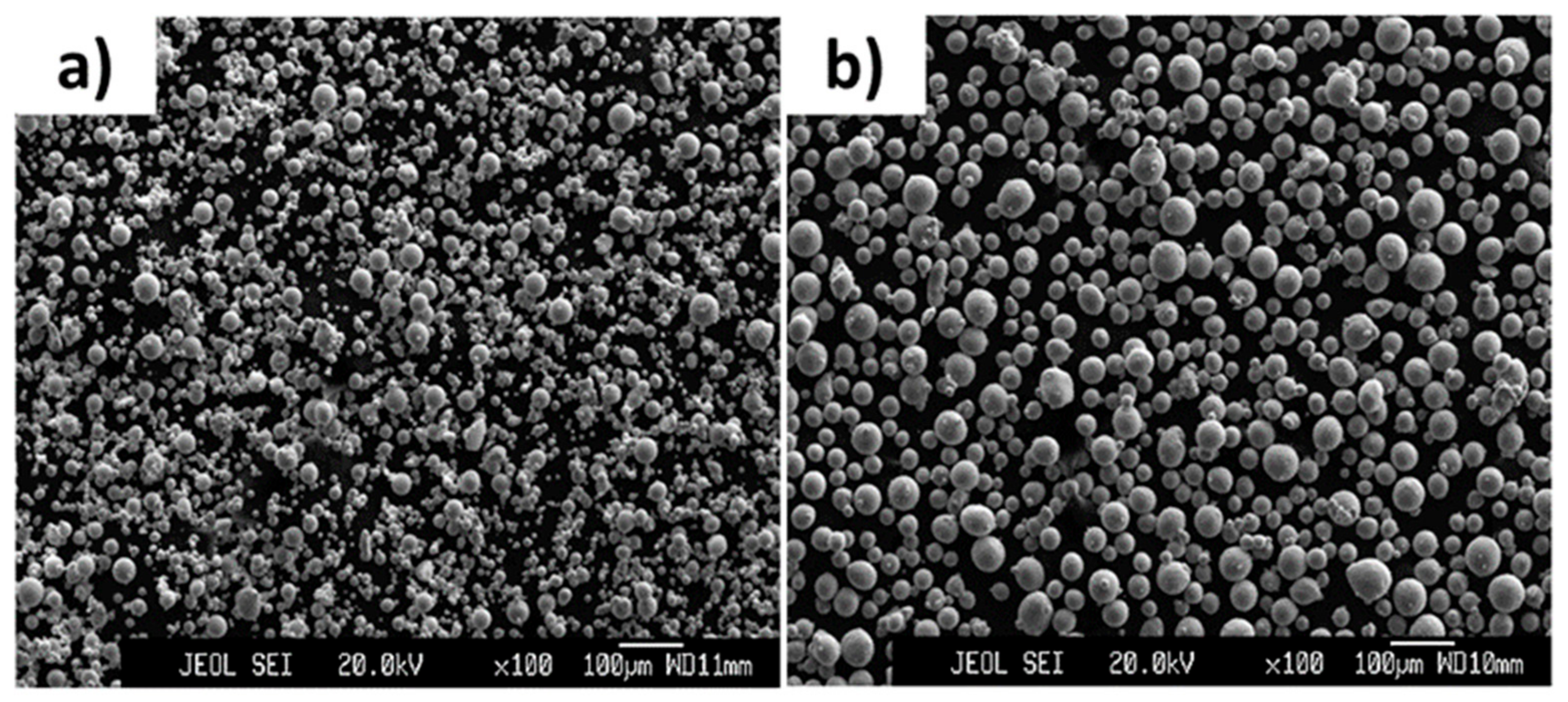

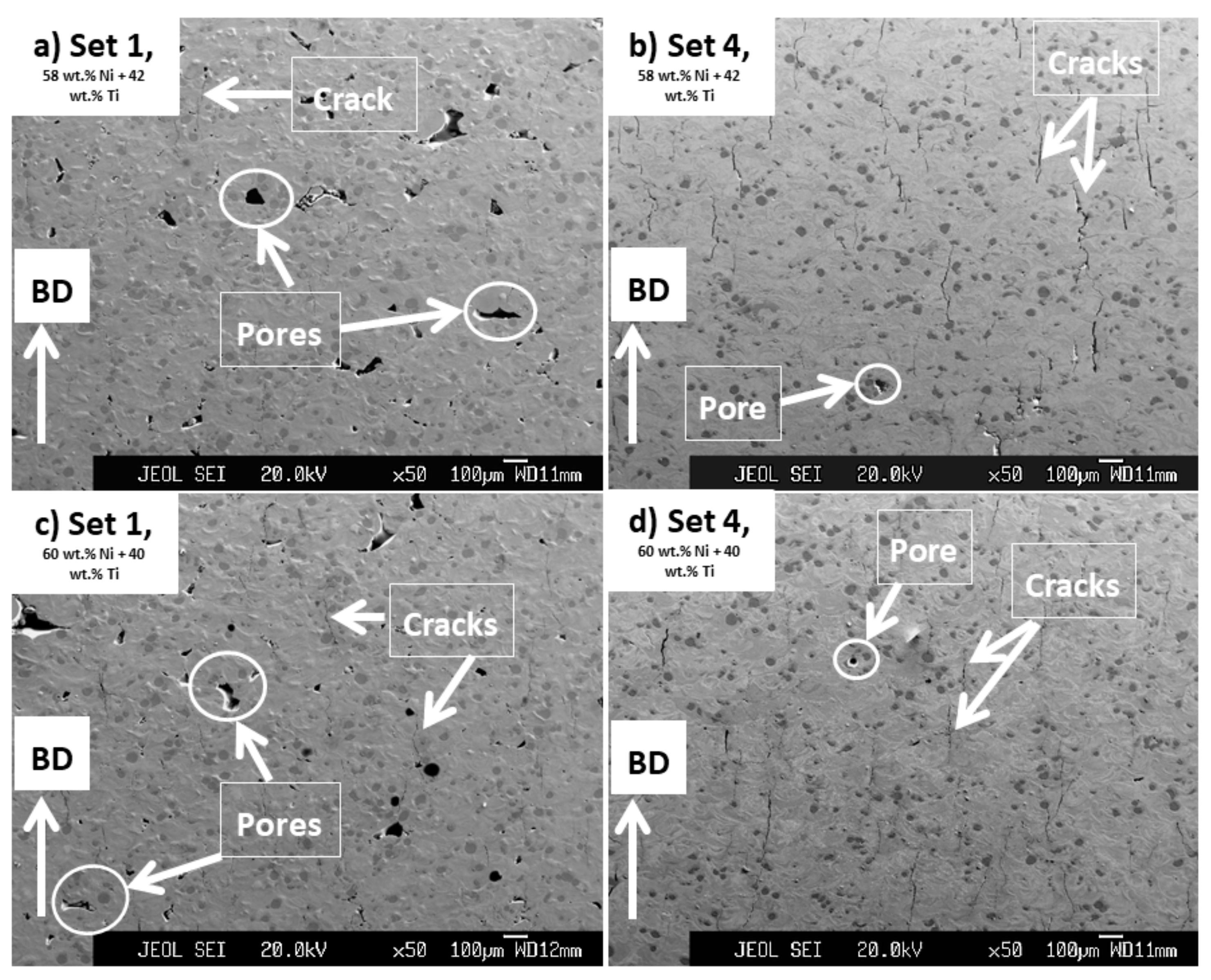



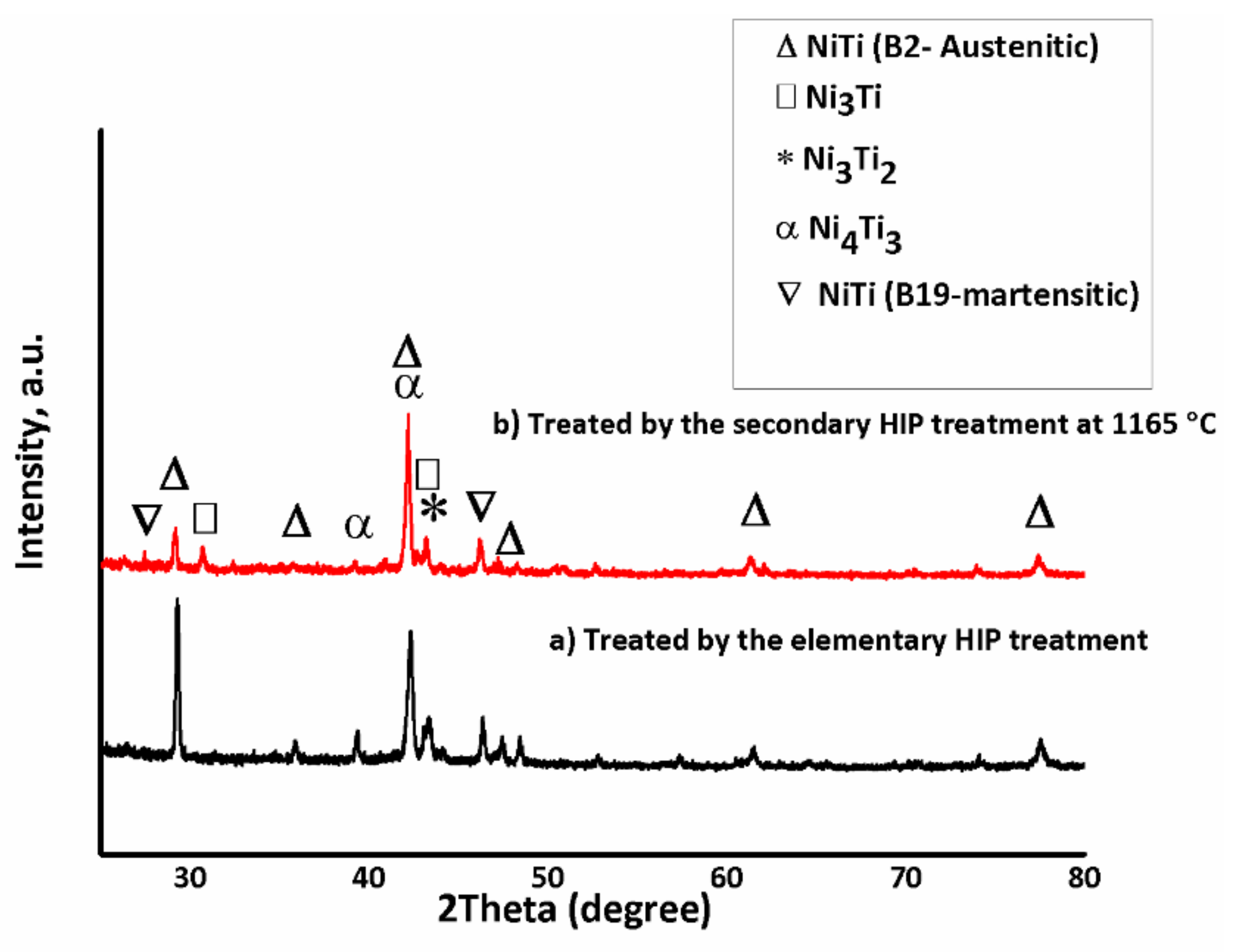
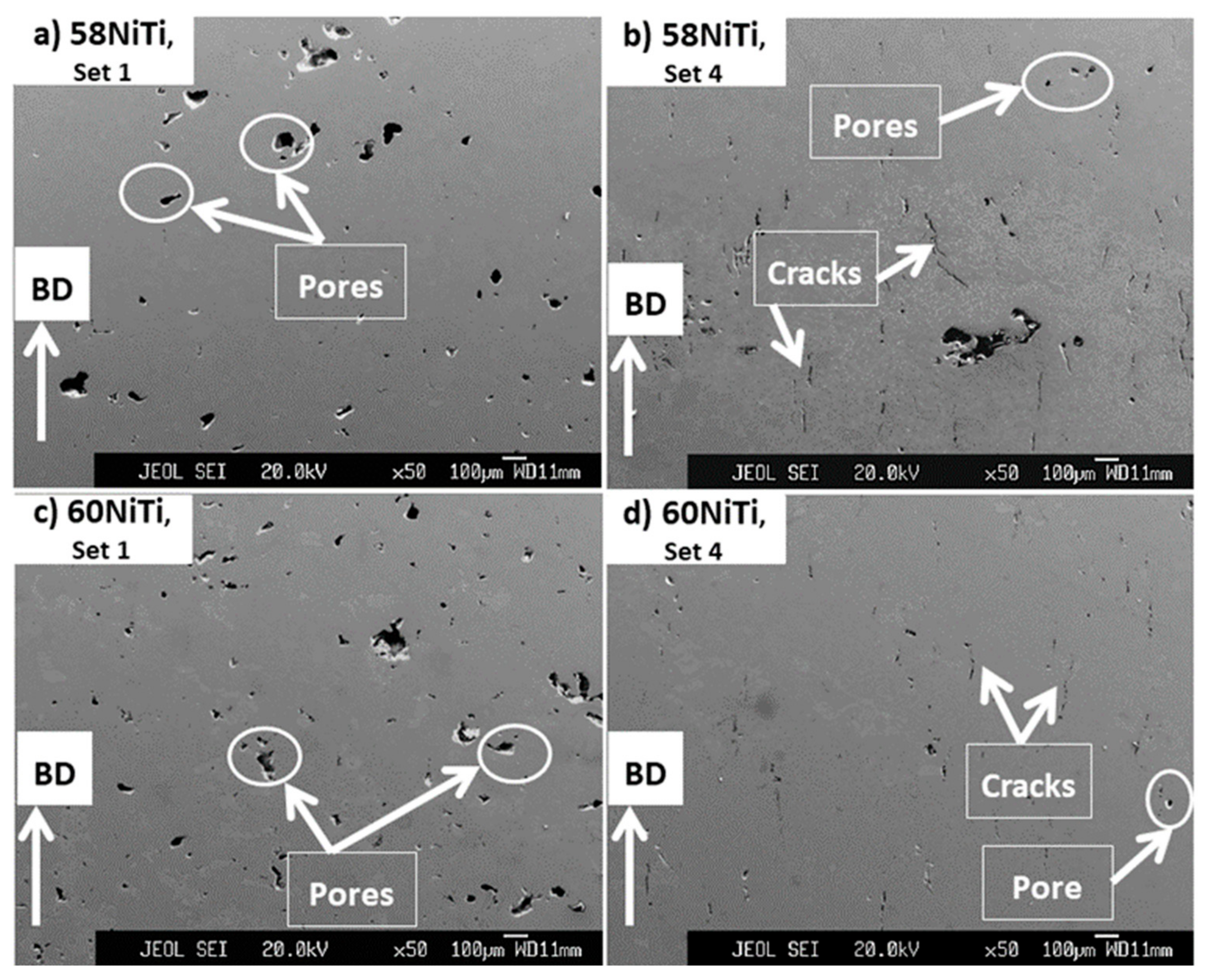

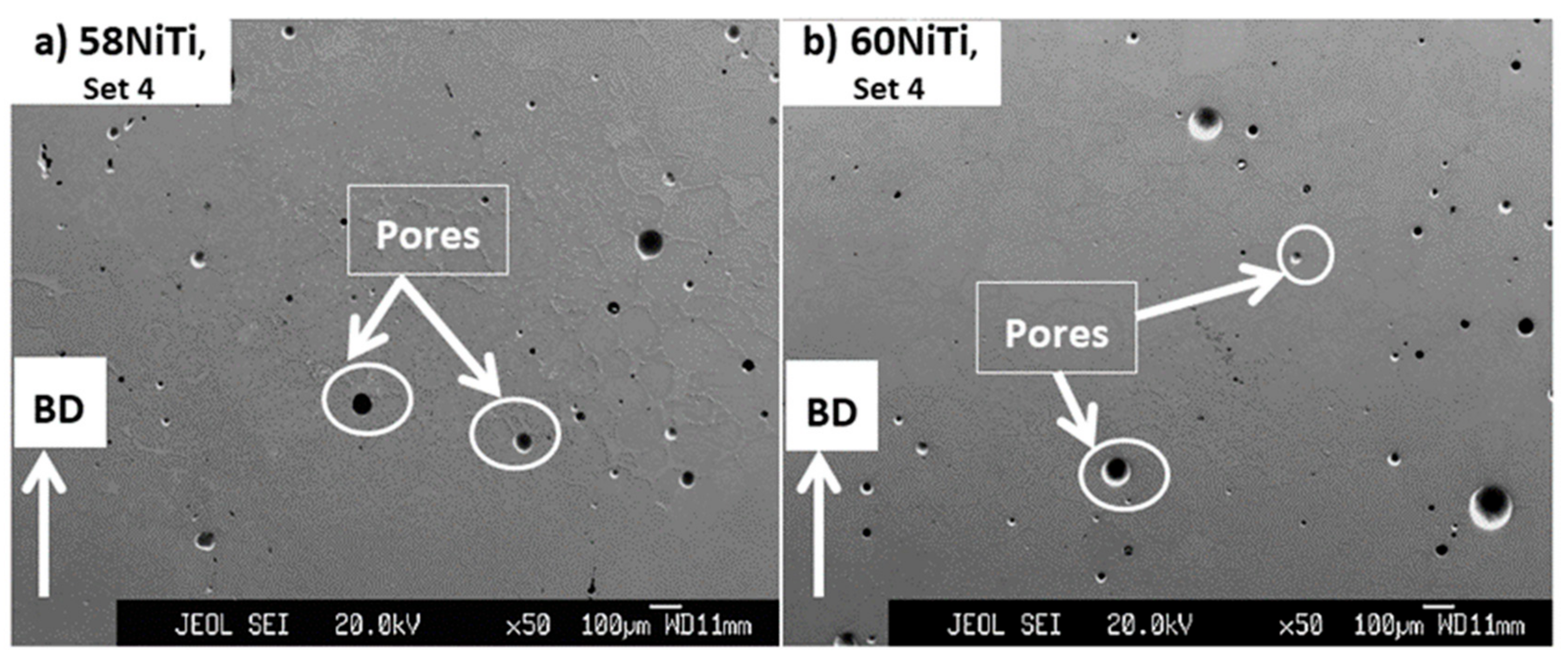

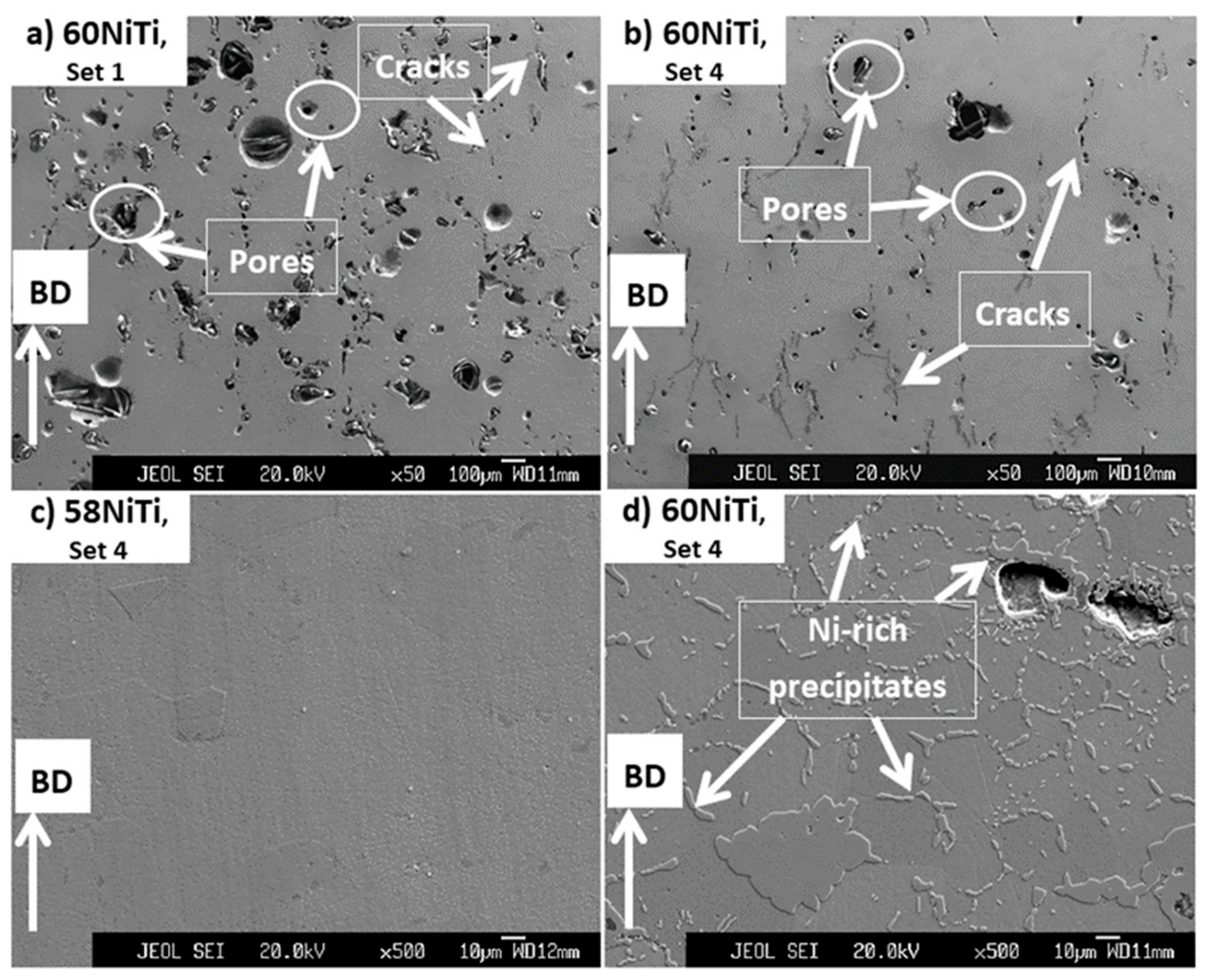
| Particle Size Distribution (µm) | Hall Flowability (s/50 g) | Apparent Density (g/cm3) | Tap Density (g/cm3) |
|---|---|---|---|
| D90 = 47.30 D50 = 33.10 D10 = 23.8 | 16.50 | 4.03 | 4.38 |
| Powder Mixtures | O (wt.%) | N (wt.%) | S (wt.%) | C (wt.%) | H (wt.%) |
|---|---|---|---|---|---|
| 60 wt.% Ni + 40 wt.% Ti | ~0.0374 | ~0.0034 | ~0.0008 | ~0.0038 | ~0.0009 |
| 58 wt.% Ni + 42 wt.% Ti | ~0.0380 | ~0.0035 | ~0.0007 | ~0.0039 | ~0.0009 |
| Printing Sets | Laser Power (W) | Scanning Velocity (mm/s) | Hatch Spacing (mm) | Layer Thickness (mm) | Volumetric Laser Energy Input (J/mm3) | 60 wt.% Ni + 40 wt.% Ti Powder-Number of Printed Samples (out of 8) | 58 wt.% Ni + 42 wt.% Ti Powder-Number of Printed Samples (out of 8) |
|---|---|---|---|---|---|---|---|
| 1 | 50 | 500 | 0.12 | 0.03 | 27.70 | 8 | 8 |
| 2 | 50 | 450 | 0.12 | 0.03 | 30.86 | 8 | 7 |
| 3 | 50 | 400 | 0.12 | 0.03 | 34.72 | 8 | 7 |
| 4 | 50 | 350 | 0.12 | 0.03 | 39.68 | 7 | 6 |
| 5 | 50 | 300 | 0.12 | 0.03 | 46.29 | 5 | 3 |
| 6 | 50 | 250 | 0.12 | 0.03 | 55.55 | 0 | 0 |
| 7 | 50 | 200 | 0.12 | 0.03 | 69.44 | 0 | 0 |
| 8 | 60 | 500 | 0.12 | 0.03 | 33.33 | 6 | 6 |
| 9 | 60 | 400 | 0.12 | 0.03 | 41.66 | 3 | 0 |
| 10 | 60 | 300 | 0.12 | 0.03 | 55.55 | 0 | 0 |
| 11 | 60 | 250 | 0.12 | 0.03 | 66.66 | 0 | 0 |
| 12 | 70 | 450 | 0.12 | 0.03 | 43.20 | 0 | 0 |
| 13 | 90 | 600 | 0.12 | 0.03 | 41.66 | 0 | 0 |
| Samples | Printing Sets Used to Process As-Printed Parts | Secondary HIP Treatment Temperatures | Conditions of Samples |
|---|---|---|---|
| 60NiTi | 1 | 1180 °C | Sample was melted |
| 1175 °C | Sample was melted | ||
| 1170 °C | Dimensional integrity affected significantly | ||
| 1167 °C | Dimensional integrity affected significantly | ||
| 1165 °C | Dimensional integrity respected | ||
| 60NiTi | 4 | 1180 °C | Sample was melted |
| 1175 °C | Sample was melted | ||
| 1170 °C | Dimensional integrity affected significantly | ||
| 1167 °C | Dimensional integrity affected significantly | ||
| 1165 °C | Dimensional integrity respected | ||
| 58NiTi | 1 | 1180 °C | Dimensional integrity affected lightly |
| 1177 °C | Dimensional integrity affected lightly | ||
| 1175 °C | Dimensional integrity respected | ||
| 58NiTi | 4 | 1180 °C | Sample was melted |
| 1177 °C | Dimensional integrity affected significantly | ||
| 1175 °C | Dimensional integrity affected significantly | ||
| 1172 °C | Dimensional integrity affected lightly | ||
| 1170 °C | Dimensional integrity respected |
| Sample | Average Relative Density (%) | Apparent Hardness (HRC) | Standard Deviation of Measured Hardness Values |
|---|---|---|---|
| 58NiTi, set 1 (Elementary HIP treated) | ~94 | ~44.8 | ~3.1 |
| 58NiTi, set 1 (Secondary HIP treated at 1175 °C) | ~95 | ~42.4 | ~3.4 |
| 58NiTi, set 1 (Hardened) | ~83 | ~19.6 | ~5.8 |
| 58NiTi, set 4 (Elementary HIP treated) | ~96 | ~43.1 | ~3.5 |
| 58NiTi, set 4 (Secondary HIP treated at 1170 °C) | ~97 | ~46.1 | ~3.2 |
| 58NiTi, set 4 (Hardened) | ~93 | ~35.8 | ~4.4 |
| 60NiTi, set 1 (Elementary HIP treated) | ~93 | ~42.4 | ~5.1 |
| 60NiTi, set 1 (Secondary HIP treated at 1165 °C) | ~94 | ~38.9 | ~4.4 |
| 60NiTi, set 1 (Hardened) | ~84 | ~26.1 | ~6.7 |
| 60NiTi, set 4 (Elementary HIP treated) | ~98 | ~42.3 | ~1.4 |
| 60NiTi, set 4 (Secondary HIP treated at 1165 °C) | ~97 | ~38.8 | ~1.8 |
| 60NiTi, set 4 (Hardened) | ~94 | ~45.9 | ~2.1 |
| Samples | O (wt.%) | N (wt.%) |
|---|---|---|
| As-printed by set 4 from 58 wt.% Ni and 42 wt.% Ti powder mixture | ~0.0405 | ~0.0037 |
| Elementary HIP treated | ~0.0455 | ~0.0195 |
| Secondary HIP treated at 1170 °C | ~0.0675 | ~0.023 |
Publisher’s Note: MDPI stays neutral with regard to jurisdictional claims in published maps and institutional affiliations. |
© 2022 by the authors. Licensee MDPI, Basel, Switzerland. This article is an open access article distributed under the terms and conditions of the Creative Commons Attribution (CC BY) license (https://creativecommons.org/licenses/by/4.0/).
Share and Cite
Khanlari, K.; Shi, Q.; Li, K.; Hu, K.; Tan, C.; Zhang, W.; Cao, P.; Achouri, I.E.; Liu, X. Fabrication of Ni-Rich 58NiTi and 60NiTi from Elementally Blended Ni and Ti Powders by a Laser Powder Bed Fusion Technique: Their Printing, Homogenization and Densification. Int. J. Mol. Sci. 2022, 23, 9495. https://doi.org/10.3390/ijms23169495
Khanlari K, Shi Q, Li K, Hu K, Tan C, Zhang W, Cao P, Achouri IE, Liu X. Fabrication of Ni-Rich 58NiTi and 60NiTi from Elementally Blended Ni and Ti Powders by a Laser Powder Bed Fusion Technique: Their Printing, Homogenization and Densification. International Journal of Molecular Sciences. 2022; 23(16):9495. https://doi.org/10.3390/ijms23169495
Chicago/Turabian StyleKhanlari, Khashayar, Qi Shi, Kefeng Li, Ke Hu, Chong Tan, Wen Zhang, Peng Cao, Inès Esma Achouri, and Xin Liu. 2022. "Fabrication of Ni-Rich 58NiTi and 60NiTi from Elementally Blended Ni and Ti Powders by a Laser Powder Bed Fusion Technique: Their Printing, Homogenization and Densification" International Journal of Molecular Sciences 23, no. 16: 9495. https://doi.org/10.3390/ijms23169495
APA StyleKhanlari, K., Shi, Q., Li, K., Hu, K., Tan, C., Zhang, W., Cao, P., Achouri, I. E., & Liu, X. (2022). Fabrication of Ni-Rich 58NiTi and 60NiTi from Elementally Blended Ni and Ti Powders by a Laser Powder Bed Fusion Technique: Their Printing, Homogenization and Densification. International Journal of Molecular Sciences, 23(16), 9495. https://doi.org/10.3390/ijms23169495








